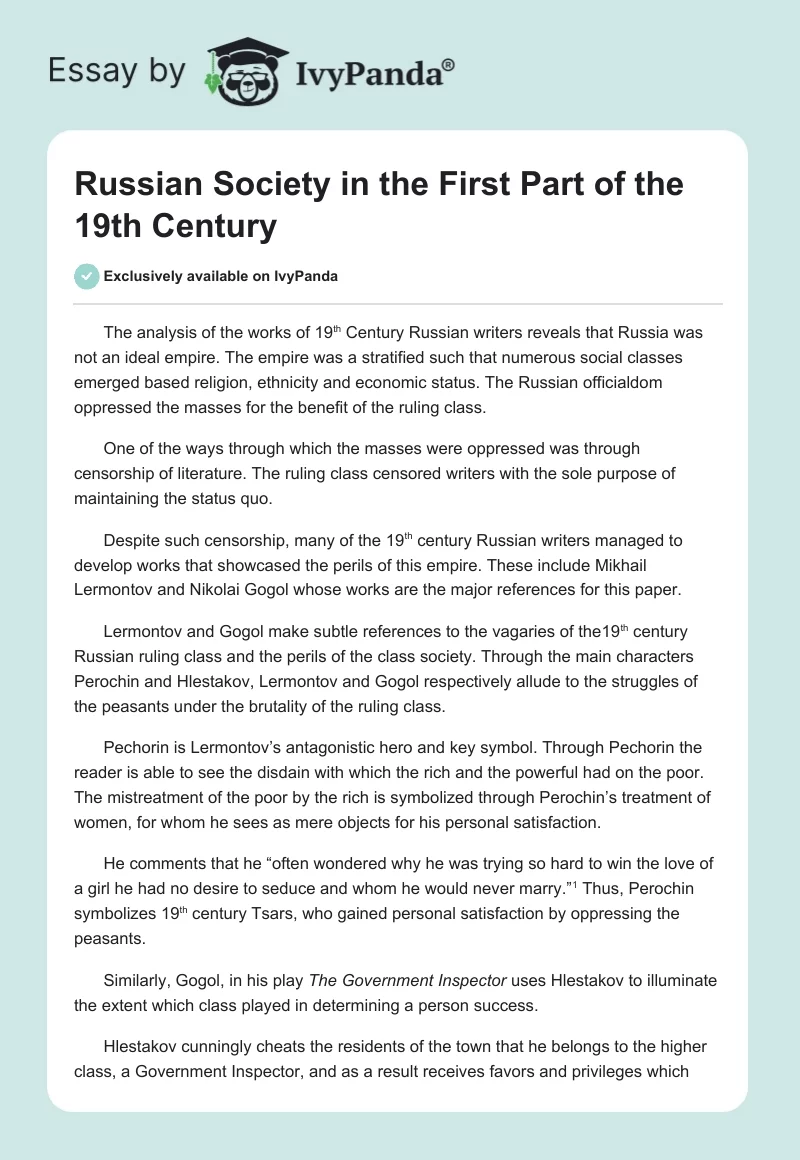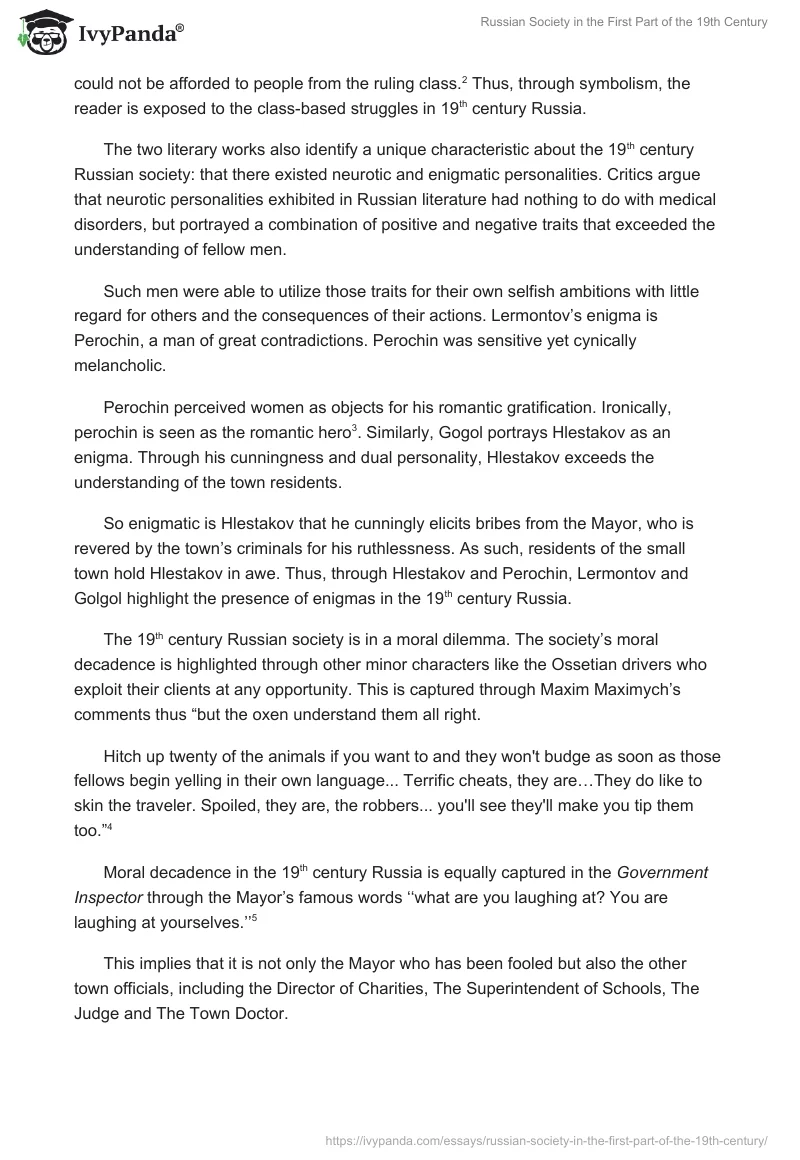The analysis of the works of 19th Century Russian writers reveals that Russia was not an ideal empire. The empire was a stratified such that numerous social classes emerged based religion, ethnicity and economic status. The Russian officialdom oppressed the masses for the benefit of the ruling class.
One of the ways through which the masses were oppressed was through censorship of literature. The ruling class censored writers with the sole purpose of maintaining the status quo.
Despite such censorship, many of the 19th century Russian writers managed to develop works that showcased the perils of this empire. These include Mikhail Lermontov and Nikolai Gogol whose works are the major references for this paper.
Lermontov and Gogol make subtle references to the vagaries of the19th century Russian ruling class and the perils of the class society. Through the main characters Perochin and Hlestakov, Lermontov and Gogol respectively allude to the struggles of the peasants under the brutality of the ruling class.
Pechorin is Lermontov’s antagonistic hero and key symbol. Through Pechorin the reader is able to see the disdain with which the rich and the powerful had on the poor. The mistreatment of the poor by the rich is symbolized through Perochin’s treatment of women, for whom he sees as mere objects for his personal satisfaction.
He comments that he “often wondered why he was trying so hard to win the love of a girl he had no desire to seduce and whom he would never marry.” Thus, Perochin symbolizes 19th century Tsars, who gained personal satisfaction by oppressing the peasants.
Similarly, Gogol, in his play The Government Inspector uses Hlestakov to illuminate the extent which class played in determining a person success.
Hlestakov cunningly cheats the residents of the town that he belongs to the higher class, a Government Inspector, and as a result receives favors and privileges which could not be afforded to people from the ruling class. Thus, through symbolism, the reader is exposed to the class-based struggles in 19th century Russia.
The two literary works also identify a unique characteristic about the 19th century Russian society: that there existed neurotic and enigmatic personalities. Critics argue that neurotic personalities exhibited in Russian literature had nothing to do with medical disorders, but portrayed a combination of positive and negative traits that exceeded the understanding of fellow men.
Such men were able to utilize those traits for their own selfish ambitions with little regard for others and the consequences of their actions. Lermontov’s enigma is Perochin, a man of great contradictions. Perochin was sensitive yet cynically melancholic.
Perochin perceived women as objects for his romantic gratification. Ironically, perochin is seen as the romantic hero. Similarly, Gogol portrays Hlestakov as an enigma. Through his cunningness and dual personality, Hlestakov exceeds the understanding of the town residents.
So enigmatic is Hlestakov that he cunningly elicits bribes from the Mayor, who is revered by the town’s criminals for his ruthlessness. As such, residents of the small town hold Hlestakov in awe. Thus, through Hlestakov and Perochin, Lermontov and Golgol highlight the presence of enigmas in the 19th century Russia.
The 19th century Russian society is in a moral dilemma. The society’s moral decadence is highlighted through other minor characters like the Ossetian drivers who exploit their clients at any opportunity. This is captured through Maxim Maximych’s comments thus “but the oxen understand them all right.
Hitch up twenty of the animals if you want to and they won’t budge as soon as those fellows begin yelling in their own language… Terrific cheats, they are…They do like to skin the traveler. Spoiled, they are, the robbers… you’ll see they’ll make you tip them too.”
Moral decadence in the 19th century Russia is equally captured in the Government Inspector through the Mayor’s famous words ‘‘what are you laughing at? You are laughing at yourselves.’’
This implies that it is not only the Mayor who has been fooled but also the other town officials, including the Director of Charities, The Superintendent of Schools, The Judge and The Town Doctor.
All these officials had bribed Hlestakov in efforts to stop him from exposing corruption by state officials. Ironically, the town merchants, mostly Jews, had also bribed Hlestakov so as to prevail upon him to dismiss the Mayor for corrupt deeds and discrimination against them.
Through Lermontov’s and Gogol’s works it is evident that the 19th century Russian society was far from ideal. The society is stratified into socio-economic classes, with those in power oppressing the poor. Such stratification and disregard for the rule of law provided suitable conditions for moral decadence to breed, as evidenced in Lermontov’s and Gogol’s works.
Bibliography
Gogol, Nikolai. The Government Inspector. Indiana: Sylvan press, 1947. 50 – 108.
Lermontov, Mikhail. A Hero of our Time. London: Penguin Books, 2009. 15 – 116.


